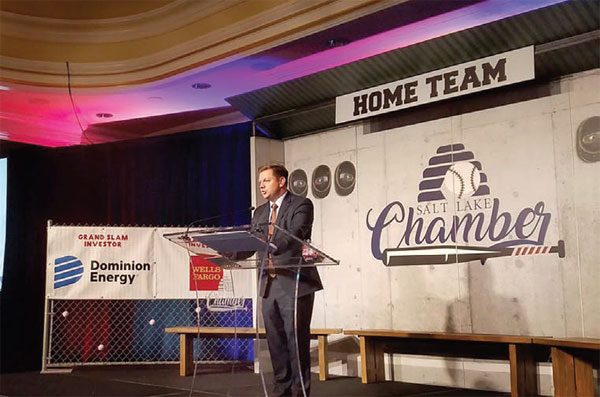By Brice Wallace
Much of the Salt Lake Chamber’s priorities in the near future will be focused on closing gaps.
As its leadership explained during the organization’s 131st annual meeting last week, Utah faces gaps in the levels of pay according to gender, in housing affordability, and between urban areas with workforce needs and rural areas needing jobs for its people.{mprestriction ids="1,3"}
Utah leads the U.S. in the spread between pay levels for men and those for women, according to an American Association of University Women study released this spring. On average, for each dollar a man earns in Utah, a woman earns 70 cents, it said.
“Out of all of Utah’s top, stellar rankings, gender wage disparity is a top ranking we should not be proud of,” Derek Miller, president and CEO of the chamber since May, told the crowd. “That is bad news for Utah. The bad news is that Utah is one of the worst in the nation when it comes to the gap in pay between men and women.
“That’s the bad news. The good news is, we can change that. We have the power to change that. As a business community, we should not have to be forced or mandated to fix this. We should, we can and we must do it ourselves.”
Miller said the chamber has partnered with the Women’s Leadership Institute to create a toolkit of best practices to address the pay disparity. It will provide the business community, individual business owners, and individual companies and leaders with “the know-how, the resources and the tools that they need to correct this problem.”
Likewise, the chamber has formed the Housing Cap Coalition to address issues in housing affordability, which Miller described as “a challenge that is quickly becoming a crisis.”
“For the first time in 40 years, Utah has more households than housing units,” he said.
A chamber-commissioned study undertaken by the Kem C. Gardner Institute at the University of Utah this year noted that several factors — a shortage of available housing, construction and labor costs, local zoning ordinances, the NIMBY (not in my back yard) mentality, land costs and topography, and demographic and economic growth — are contributing to housing costs rising more quickly than Utahns’ incomes.
The chamber formed the Housing Gap Coalition “because we want our employees, our children and our grandchildren to enjoy a reasonable cost of living, a high quality of life and strong economic prosperity that we all in this room have enjoyed,” Miller said. “To do this, we must tackle Utah’s housing affordability crisis today, not tomorrow.”
Miller also called upon chamber members to get involved in rural economic development by reviewing the job openings they have at their companies and identifying which ones “don’t need to be located along the Wasatch Front.” The chamber will help them find rural communities that “have the workforce that match your needs,” he said.
Many companies along the Wasatch Front say their biggest challenge is finding workers, while in rural Utah, the biggest challenge is finding jobs for its people, he said.
“Despite all of the great things that are happening in our state, the truth is that not all communities are enjoying the fruits of economic success the same way,” he said. “While Utah as a whole has the highest job growth and one of the nation’s lowest unemployment rates, in many parts of our state, the story is much different, with high unemployment and job growth so low that that population is dwindling.”
Steve Starks, chairman of the chamber board for 2018-19, called upon chamber members to understand that “our community is changing” and to welcome “new ways of thinking, ideas and people to the table. Our responsibility as business leaders is to be open to new thinking, new approaches and new voices.”
He encouraged members to make transplants to the Utah feel welcome, hire them, listen to them and engage them, as well as share with them “all that is good about Utah.” By helping them navigate their challenges, “they will be equally invested in our great state,” he said.
As part of that effort, the chamber has started “The Hive” as a way of aiding the next generation of leaders.
“This group will focus on building our community’s bench of capable and impactful leaders,” Starks said. “Additionally, we will ask them for their input and guidance on significant state and community issues such as air quality, diversity in the workplace, the inland port development and the Point of the Mountain process, to name just a few.”
During the meeting, the chamber presented its annual awards. The Community Partner of the Year is Intermountain Healthcare. The Corporate Partner of the Year is Goldman Sachs & Co. Parr Brown Gee & Loveless received the President’s Award for Excellence. The Chamber Champions are Vance Checketts, DSCO; Janet Healy, Catholic Community Services of Utah; Ray Pickup, WCF Insurance; Sally Steed, Utah Media Group; and Brittany Westover, JP Morgan Chase.
The chamber is Utah’s largest business association. It includes more than 63,000 employers with more than 1.4 million workers. It has members in all 29 Utah counties and in 18 states.{/mprestriction}








